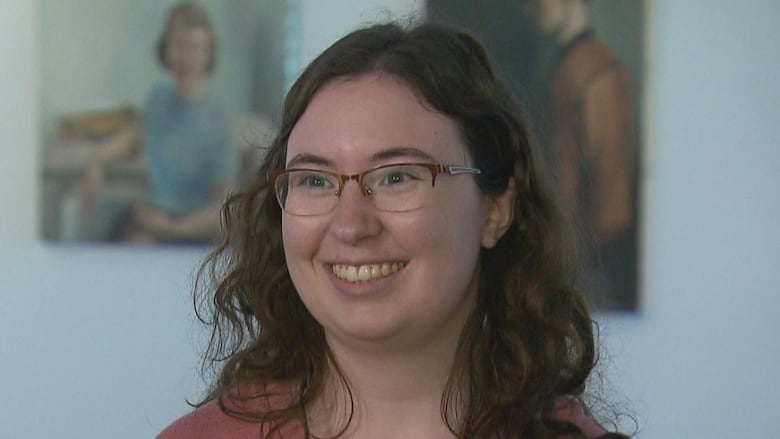Touching up history: An intern hopes her painstaking work is so good, it won't be noticed
Art conservator Winnie Daley forgoes sunny days for the gallery basement, where she mends art

It's a beautiful summer day outside, but Winnie Daley happily works away in the chilly basement of the Owens Art Gallery in Sackville.
She's in the painting conservation lab, meticulously applying gold leaf to a section of frame that will surround a 135-year-old painting.
The painting is called An Intruder. The artist is Frederick Juengling.
And if all goes according to plan, no one will ever notice Winnie Daley's weeks of work.
"Preferably, whenever people go to the museum they shouldn't really be able to see what sort of damage happened to the art," she said.
"They should be able to appreciate the art as it is and not be able to see, 'Oh, it used to have this problem.'"
The Juengling painting is just one of more than 4,000 that make up the Owens Art Gallery's permanent collection. The works are stored in a basement room called "the vault," hung on sliding walls, each carefully catalogued and conserved.
Daley is interning at the gallery through the master of arts program in conservation at Queen's University in Kingston, Ont.
She needs hands-on experience as a conservator, and the Owens Art Gallery on the Mount Allison University campus is the only art conservation lab in the province.
Originally from Prince Edward Island, Daley wanted to be close to home for the summer.
She decided to train in the art of painting conservation because it draws on her different interests.
"Honestly, I didn't want to choose between doing science courses and doing arts courses. I wanted to do both."
Art conservation allows that.

Patricia Smithen, the director of the art conservation program at Queen's, said each student must have taken organic chemistry, and painting conservation students also have to submit an art portfolio.
"We have weird prerequisites to get into our program because we're a real mix of science and art, you have to have things like organic chemistry, so that limits the amount of people who can apply to the program."
Each year, only 11 people are admitted to the Queen's program, the only one of its kind in the country.
Art conservation is a "hidden profession," Smithen said.
"Not a lot of people even know we exist."

But students who graduate from the program go on to work all over the world in museums, galleries and in the private sector.
The Owens Art Gallery has a full-time art conservator, but with thousands of paintings to look after, Emily Falvey, the director and curator at the gallery, said interns are a valuable resource.
"It's very important. Repairing the work is important because it restores it, it also stabilizes it so it will last longer," she said.
For that reason, heat and humidity levels are taken very seriously at Owens Art Gallery. It's kept at a steady 20 C and 50 per cent relative humidity, said Falvey.
"This is because a constant, stable environment prevents materials in artwork from deteriorating. When there are wide fluctuations, materials expand and contract, and this movement causes damage such as cracked paint, warped wood, creased paper etc."

While the gallery may provide a constant environment, many paintings it obtains are from private collections, where they were stored on walls in homes in less-than-ideal conditions.
Taking a break from the gilded frame, Daley worked on a small painting by Elizabeth McLeod. She guessed it had hung in a room with a wood-fired stove or fireplace.
"It was quite dirty. It had a lot of soot on it and so I cleaned all of that off."
After dozens of hours of cleaning, Daley is restoring the painting by filling in spots missing colour. It's high pressure work.
"Obviously, you don't want to damage it at all."
"The goal is to basically to respect what was there before, for this I try to match the colour and the texture and the gloss of what was previously there."

Daley said an important part of her work is ensuring everything she does to the work is reversible.
"I'm not using the same kind of paint that the artist used, so if I make a mistake with the paint that I'm using I can easily remove it and do it again without removing their paint."
The most well-known example of a painting restoration gone wrong belongs to a 19th century fresco that was ruined by an elderly Spanish woman who attempted to restore the mural.
The painting, a sophisticated depiction of Jesus with the crown of thorns around his head, has been transformed into an amateurish, almost cartoon-like portrait.
With a laugh, Daley said, "the point of our program is to learn to not do that."

Daley said she loves the work because there's always something different to do, and while others may not see her work, she can. Her favourite part is always the final result.
"Seeing ... something that maybe somebody would have thrown out and then knowing that you can make it really lovely and make it look not quite the way it looked before but pretty close."